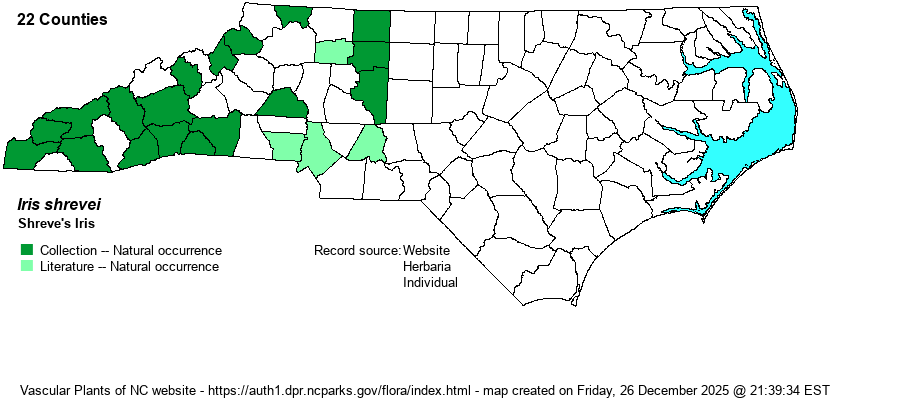| Section 5 » Family Iridaceae |
Show/Hide Synonym
| taxonName | relationship | relatedTaxonName | relatedTaxonRefText | relComments |
|---|
|
|
| Iris shrevei | = | Iris virginica var. shrevei | Gleason and Cronquist (1991) | | | Iris shrevei | = | Iris virginica var. shrevei | Fernald (1950) | | | Iris shrevei | = | Iris virginica var. shrevei | Kartesz (1999) | | | Iris shrevei | = | Iris virginica var. shrevei | Flora of West Virginia | | | Iris shrevei | < | Iris virginica | Flora of North America (1993b, 1997, 2000, 2002a, 2002b, 2003a, 2004b, 2005, 2006a, 2006b, 2006c, 2007a, 2009, 2010) | | | Iris shrevei | < | Iris virginica | | | | Iris shrevei | < | Iris virginica | Radford, Ahles, and Bell (1968) | | | Iris shrevei | < | Iris virginica | | | | Iris shrevei | < | Iris virginica | Flora of Virginia | | | Iris shrevei | < | Iris virginica | Wofford (1989) | | | Iris shrevei | = | Limniris shrevei | | | | Source: Weakley's Flora |
|
| Author | Small | |
| Distribution | This is the montane form of the widespread Iris virginica, given the name Iris shrevei many decades ago by Small. Those familiar with the dot maps in RAB (1968) have noticed the disjunct, two-parted range of I. virginica in the book; those records in the Mountains and western Piedmont are now assigned to I. shrevei. It ranges across the Mountains, and very spottily into the western Piedmont -- east to Stokes and Davidson counties. Some records, especially in the Piedmont portion of the range, might be of planted individuals at parks.
This species is primarily Midwestern, the western counterpart of the I. virginica complex. It ranges north to Southeastern Canada and MN, south to western NC, northern AL, and eastern KS. | |
| Abundance | Uncommon in the southern Mountains, north to Buncombe County, but rare in the northern Mountains. Very rare and local into the western half of the Piedmont. As this species is not listed by NatureServe, based on BONAP taxonomy, but it is by Weakley (2018), this website must provide a speculative Global Rank, and judging by its wide range on the BONAP map for I. virginica, it is likely a G5 species. The editors added the Q to the rank to indicate the taxon being of questionable taxonomy. | |
| Habitat | This is a wetland species of marshes, openings and edges of swamps, and along streams. It apparently does not occur in the state's bogs, but if it does, it is much less frequent than in marshy areas around lakes and ponds or ditches. | |
| Phenology | Blooms from May into July, and fruits from July to September. | |
| Identification | This is the tallest of the native Iris species in NC, with the stem ranging nearly to 3 feet high. As it is a split from I. virginica, most characters are the same as for that species, with rather broad and long strap-like basal leaves that reach at least 2-2.5 feet long and about 1 inch wide. As with other irises, the leaves are arranged such that one edge faces the stem. The large flowers can be up to 4 inches across, with wider sepals than found on I. prismatica; the petals are smaller and more erect. One to several flowers are found on each stem, though only one blooms at a time. Flower color is mostly violet-blue (leaning to blue), with some white and yellow on the perianth parts. Weakley notes three characters that separate this species from I. virginica -- a taller flowering stem (up to 3 feet rather than up to 2 feet tall), a stem with one or two well-developed branches (versus mostly unbranched in I. virginica), and a capsule of 3-4 inches long (versus 2-3 inches long in I. virginica). Normally, a biologist will simply identify this species by its range, as it is the only tall native iris in the Mountains and the western Piedmont. However, any irises in the central Piedmont could be either of these two species, and thus closer examination would be needed. As these irises often grow in dense stands, a sight of such a stand in a marsh is quite showy. | |
| Taxonomic Comments | As mentioned above, only recently have a few authors split this out of I. virginica and treated it as a full species. Most still retain it within the latter species, but surprisingly not even as a more western variety or subspecies. This website follows Weakley's (2018) taxonomy.
| |
| Other Common Name(s) | Blue Flag Iris, Wild Iris, Blue Flag. Note that all of these names can also refer to I. virginica, and thus cannot be used as the common name on this website. | |
| State Rank | S3? | |
| Global Rank | GNR [G5?] | |
| State Status | | |
| US Status | | |
| USACE-agcp | | |
| USACE-emp | | |

